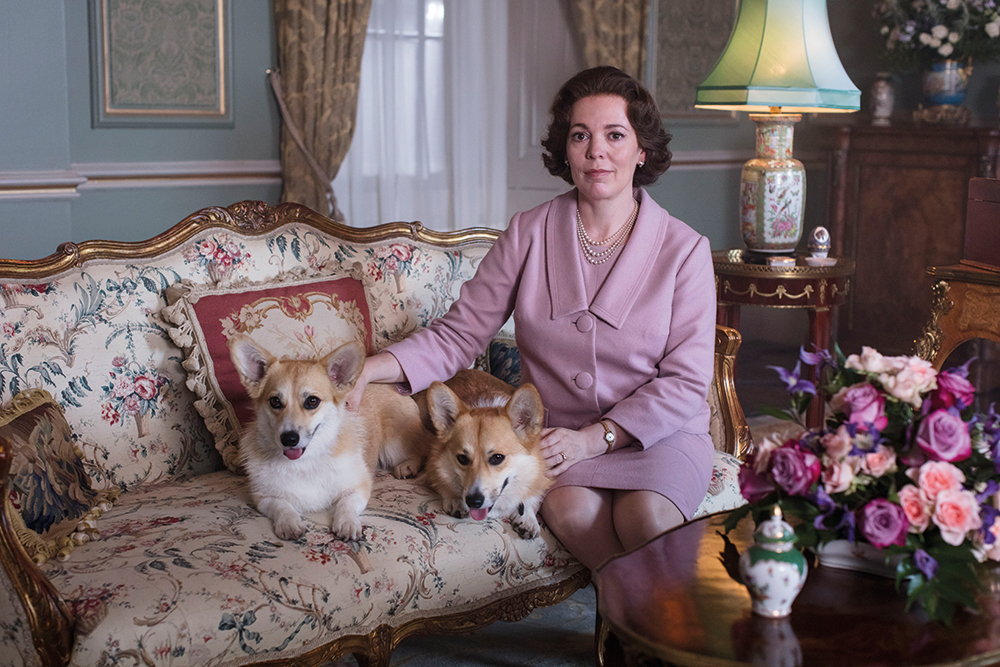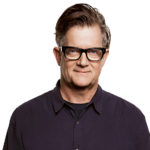
Passing the Crown
Posted on Oct 25, 2019 by Alex Fice
DOP Adriano Goldman dissects the new look for Series 3 of the royal drama, now led by the Oscar-winning Olivia Colman
Words Chelsea Fearnley / Pictures Netflix
The Crown Series 3 will continue the first two series’ delicate blending of private and public events with a sensational new cast and narrative. It will cover the years from 1964 to 1976 – the era of sex, drugs and Camilla Parker Bowles – and document the early blossoming relationship between her and Prince Charles, as well as what was known as a particularly bleak period for the British people, characterised by strikes, power cuts and IRA bombings.

DOP Adriano Goldman, who has already started shooting Series 4 of the Netflix series, references the evolution of the show and says it’s getting grittier. “If you think back to Seasons 1 and 2, there was always a parallel in the story between what’s happening with the royals at the palace and what’s happening with the prime minister at Downing Street. This is still the case for Season 3, but it’s pacier somehow, there are more scenes, more sets and I remember speaking to the production designer Martin Childs, who said he had created almost 400 sets just for the new season.”
 The Queen with her beloved corgis
The Queen with her beloved corgis
This progression of the storyline meant that Goldman was more cautious about changing his shooting style to match the period. He explains: “Visually, the show is already going to change. I knew this from the first moment I read the script; there’s modern architecture, costumes and furniture, and because we’re following different characters, we’re going to be moving outside of familiar locations and exploring new ones. Of course, we knew we had to make some changes, to evolve the look and present something fresher, but we weren’t going to go handheld or start questioning all our style rules. It still needed to look like The Crown.”
The Crown’s style rules hail from Series 1 and originated from the initial director Stephen Daldry. They drive everything Goldman shoots and were developed for visual consistency, because the series has several DOPs working on it.
We knew we had to make some changes, to evolve the look and present something fresher
“These rules change only ever so slightly for Season 3. We used to be physically close to the actors for close-up shots using a 50mm lens, but gradually – and this is actually more perceptible in Season 4 – we’ve been stepping away from the actors and lensing up. It feels more voyeuristic, like we’re watching in, and that adds to the increased grittiness of the show,” explains Goldman. “From a technological perspective, the lenses also had to change. We had previously been using Cooke Panchros from the fifties
and now we’re using Zeiss Super Speeds from the late sixties and seventies. They’re still vintage lenses, but they’re less glossy and more suited to the period in which Season 3 is set.”

The lenses were tested before shooting to ensure colour and density accuracy across the sets. He explains: “Of all the Zeiss Super Speeds available on the market, each of them ages differently, and we had to find four sets that produced an identical image. We needed at least four sets: two sets per unit, and eventually four sets per unit when double banking – this is something that happened quite frequently on The Crown. We started with a single unit, then a second unit came in to provide additional material. Then there would be a whole other unit working with another director and DOP on other episodes.
“We didn’t test the body, because we chose to stay with the Sony F55. The decision to keep the same camera we had used for the previous two seasons derived from comfort; knowing that Netflix was pleased with the workflow and overall quality of the production. Though – and this might sound a little contradictory – we did switch to the Sony Venice for Season 4. It’s a much more modern toy and it gives me more speed and more quality as a whole. I can also still shoot in 4K, so there’s consistency there.”
Goldman continues: “If I advanced to 5K, I would need to find other lenses capable of covering that sensor size, and there’s also no real reason to shoot in more than 4K right now.”
 The decorated war hero Prince Philip
The decorated war hero Prince Philip
This show isn’t supposed to be super glossy or have a super-romantic look – it’s supposed to feel real
 The Queen arrives for the state funeral of Winston Churchill, followed by the Sony F55 on a Steadicam
The Queen arrives for the state funeral of Winston Churchill, followed by the Sony F55 on a Steadicam
Realistic lighting
Goldman approached lighting the same way he had done since Series 1 of The Crown. He likes an empty set to give the director and talent plenty of room to play around with, and so chooses to light all of his scenes from the outside in.
He explains: “If you come to my sets, they always look very simple. I rely a lot on windows and what is supposed to be a natural light source, like the sun or sky. I also like to use practicals, to enhance skin tone or make the actors’ eyes sparkle, so I work closely with Martin Childs and his department to determine which practicals would work best for the work I’m doing. It’s usually things like how thick the shades are or what’s the strongest bulb I can have on a certain practical. It’s a realistic approach. This show isn’t supposed to be super glossy or have a super-romantic look – it’s supposed to feel real.”
 The new Queen and her prince, played by Olivia Colman and Tobias Menzies
The new Queen and her prince, played by Olivia Colman and Tobias Menzies
Goldman also felt inclined to upgrade his lighting gear. He didn’t use any LED sources for the first two seasons, but Series 3 and 4 both employ Arri SkyPanels,
Cineos and the Hudson Spider. He explains: “I really like how quick and easy it is to adjust the intensity and colour of LED lights, so that helped me keep the pace up. We shot about 25 set-ups a day, so we needed to be able to move quickly in order to deliver the footage on time, and switching up both our lenses and lights meant we could do that.”

Colour evolution
Asa Shoul is one of the originals and has worked on The Crown since Series 1. He was invited to interview for the series following the work he did on The Queen, which was written by Peter Morgan. He was initially asked to do some test grades with Goldman, and they started by comparing three different cameras, and some exterior street scenes and interior locations.
He says: “We also extensively tested makeup and in particular, Queen Elizabeth’s lipstick, which initially turned magenta when we applied a cool grade. The makeup team gave Adriano several shades to work with until we were happy with one that I wouldn’t have to isolate and change for every shot.
Early on in the tests, we also looked at the possibility of the 2.35:1 aspect ratio and, although cinematic, it didn’t quite feel right. I suggested a 2:1 ratio, which made it more cinematic than a 16:9 full frame, but still gave the glorious palace interiors the feeling of height, which helped with making the young Queen feel small within those imposing spaces.”
Once filming had started, Shoul and Goldman found a colour palette and contrast level they felt worked for most situations. But the darkness of the series came from discussions about characters’ isolation from the outside world and wanting them to feel as if the only light reaching them was from the distant windows. “We called this ‘putting them in the room’, which was a refreshing change from what has become the norm in many TV dramas, where you see unusually bright interiors,” explains Shoul.
Although there are a number of rooms The Crown returned to across the three seasons, such as the royal audience chamber, where the Queen meets her prime ministers, Shoul and Goldman wanted subtle differences in the grade to keep the drama fresh, and to hint at the individual emotion of each scene. Shoul also notes that working on a Netflix production is a luxury because, “all ten episodes are live at the same time”, enabling him to explore different looks and return to an episode if he found something that worked better later on in the series.
Lighting through the windows of grand buildings and placing the equipment well away from the talent demanded a huge chunk of the budget for cherry pickers and genie booms (and getting permits for these enormous machines to be outside on the street). “On the set, there’s always two Pee Wee dollies and five or seven (usually 50ft) cranes. Either technocrane or Scorpio. But there are a few locations, such as at Wilton House, where there are weight restrictions, because of its old, wooden flooring. In these instances, we brought a 22ft technocrane, which is a very small, beautiful piece of gear. I know the show looks expensive – and we do have the resource, but my philosophy is to keep the set simple, with two cameras, two dollies and few cranes.”

Brown-eyed girl
Much as we, the audience, love a good side-by-side of actors and the historical figures they portray, we accept the inevitable differences. But not the makers of The Crown, who sought so desperately to match Olivia Colman’s likeness with the Queen through cosmetic and visual effects. The feature in question was Her Majesty’s blue eye colour, which the Oscar-winner’s predecessor in the role, Claire Foy, was fortunate enough to share.
There’s a very strong artistic connection felt among the team. It’s just so different to working on a feature film
Colman’s tawny-coloured eyes were initially fitted with contact lenses, but that idea was quickly abandoned because they made the actor appear “zombie-like” and as though she were “acting through a mask”, says Goldman. Furthermore, when shooting Colman up close, her contacts were visible on screen. Recolouring Colman’s eyes using VFX was also vetoed, because it didn’t seem like her when she was acting. Goldman explains: “You lose something when you watch Olivia with blue eyes, something vanishes, and it really damages her performance.”
 Tony Armstrong and later, Lord Snowdon, was famed for his post-war fashion photography
Tony Armstrong and later, Lord Snowdon, was famed for his post-war fashion photography
He adds: “If you’re making a sci-fi movie and you need a character to have red eyes, that’s one thing – it’s part of the construction of that character. But, you know, we’re not making a documentary here, and we’ve been bold enough to change an entire cast, does it really matter if Olivia has brown eyes?”
Continuity was also questioned when the footage came into the grade, but it was decided that most of Series 3’s “new feel” would be achieved by the changes in cast, costume, sets and lenses. Colourist Asa Shoul explains: “We wanted to anchor the look so that it would be unmistakably The Crown, therefore the grade didn’t vary much from Seasons 1 and 2, other than the primary delivery now being HDR. This was perhaps the most dramatic and, at times, controversial new tool at our disposal. Adriano embraced it as it added an extra dimension to the viewing experience; an immersive 3D quality. But it has to be used subtly, so as not to become distracting. We didn’t want the actors to have to compete with the lights.”

He continues: “We found that establishing a shot of a vista across a city, such as in Athens, where we follow the story of Prince Philip’s mother, had such depth that it could easily be held for another five seconds as our eyes were drawn to different details within the image. We therefore suggested the editors should be able to view the dailies in HDR so they could have a similar experience during the edit.”

Series 3 is naturally more colourful, because the period is more colourful, so this led to a conversation about saturation and whether or not it needed to be enhanced for the new season. Goldman says: “We did think about saturation, and I remember having interesting discussions about saturation for the period. I’m very much guided by skin tone, so that was the crux of the discussion, you know, in terms of what works best for Olivia and Helena Bonham Carter [who succeeds Vanessa Kirby as Princess Margaret]. I wasn’t trying to match their skin colour with Claire or Vanessa’s, but it needed to look consistent with the saturation of the period.”
He continues, “I feel confident enough knowing that we own the look for The Crown. So, if we wanted to go a little bit more colourful, we could. However, if Martin Childs suddenly started painting all the set walls green, we would probably need to have a discussion with our costume designer Amy Roberts about keeping the costumes more of a brownish, muted colour – but that would never happen. We all know the show so well and we’re all so close with each other.”

This enviable rhythm that defines the look for The Crown grew from the cast and crew friendships on and off set. Goldman explains: “After doing three, almost four seasons together, there’s a very strong artistic connection felt among the team. It’s just so different to working on a feature film, where you have to start from scratch and assemble a whole new team together each time.”
He adds: “But even the newcomers, the new cast members, are a joy to work with. I heard from a new actor in Season 4 who, after stepping onto the set for the first time, said, ‘Coming to The Crown is like sitting in a Rolls-Royce. It’s so safe and comfortable, and very high-end.’”
Goldman concludes: “We are really proud of the work we do together, and I sincerely hope that Season 3 is received as well as Seasons 1 and 2 were.”








